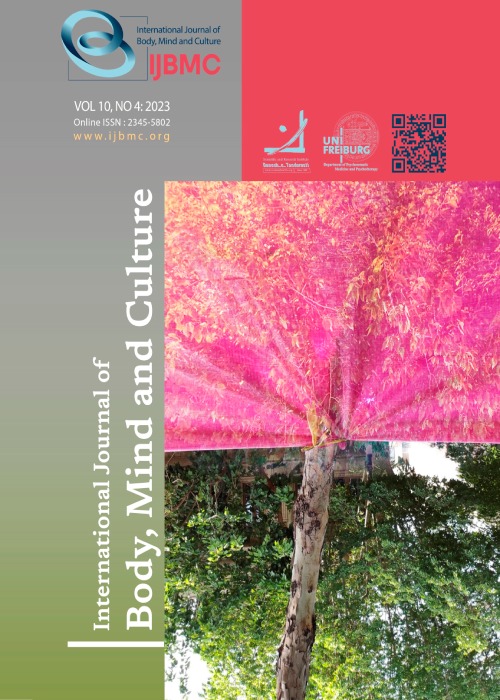فهرست مطالب

International Journal of Body, Mind and Culture
Volume:7 Issue: 3, Summer 2020
- تاریخ انتشار: 1399/05/11
- تعداد عناوین: 8
-
Pages 110-118
The discussion about ethics in the psychotherapeutic field is increasingly broadened by the necessity to not only develop ethical guidelines, but also to deal with their application and implementation in a very concrete way. This article is not about processing and presenting individual ethics cases, but rather about describing the necessity of such a practice context and underlining the structure of a relevant procedure as a necessary component of ethics in the psychotherapeutic field. The article shows successful structures and practice of ethics by means of concrete examples. It extends the study of ethics in the psychotherapeutic field to the management of ethics in relation to the respective psychotherapeutic organization. Especially the application, the structure of the procedure and the practice of ethics bring the occupation of ethics as a method into the focus of the discourse. Ethics as a method is not to be handled arbitrarily, but as a process of discourse, an arrangement, and a joint coordination of relevant plausibilities in the respective therapeutic organization as well as in the psychotherapeutic field.
-
Pages 119-125
Reading medical texts is always a serious challenge for medical students because they are expected to be able to apply it in clinical practice. Studies show that medical students fail to use the content of medical texts in clinical practice. In many cases, this failure is attributed to incomplete or incorrect learning of the contents of the books, and the lack of a suitable guide for better and more effective reading of medical resources. The question addressed in this article is how medical texts should be read in order to be used in daily clinical practice. This article will be divided into two parts. In the first part, an attempt is made to address theoretical foundations based on illness script theory. In the second part, by quoting a part of a medical reference book, we try to show how medical texts can be read effectively.
-
Pages 126-139Background
Unusual accumulation of fat in the body is called overweight or obesity, which can affect health. This study tends to develop and investigate the effectiveness of bioenergy economy program in body self-concept and weight loss of women with obesity.
MethodsThe methodology used was a quasi-experimental design with pre-test, post-test, and control groups. The statistical population included obese people referred to psychological counselling centres and nutrition clinics in Tehran during 2019. Fifty obese women were selected by the convenience sampling method and randomly assigned to two experimental and control groups. Data were collected using Cash's Multidimensional Body Self Relations Questionnaire Then, weight and body mass index were calculated in the participants. According to guidelines for the bio economics protocol developed at the Energy Medicine University of California, a specific training package was developed for obesity and the intervention group was trained in eight sessions of 120 min for 8 weeks. Data were analysed by the analysis of covariance using SPSS software version 24.
ResultsThe results showed that the effect of bioenergy economics was significant on the attitude towards body image (P < 0.01).
ConclusionTo conclude, a bioenergy economy program can be an effective program in the body self-concept body self-concept . Considering the effect of this therapeutic approach on the body self-concept and assuming the effects that may occur as a result of changes in this perception, it seems that this new intervention will have a positive effect on the weight control process over time. It is possible that the effect of this treatment on weight loss can also be seen by following this variable in the future.
-
Pages 140-150Background
Nurses are exposed to mental and physical illnesses due to burnout and high job stress and lack of adequate adaptation resources, and ultimately, reduced mental health. The aim of this study was to determine the effectiveness of self-differentiation training on psychosomatic symptoms and cognitive emotion regulation in nurses.
MethodsThis quasi-experimental study was conducted with a pretest-posttest design and a control group. The study population consisted of nurses of Omid and Jamaran hospitals in Tehran, Iran. From among them, 36 nurses were selected based on Morgan's table using convenience sampling method and were randomly divided into two groups (experimental and control) of 18 individuals. The experimental group underwent 10 training sessions (once a week for 60 minutes) based on Bowen's system theory, during which time the group did not receive training. Screening for Somatic Symptom Disorders-7 (SOMS-7) questionnaire and Cognitive Emotion Regulation Questionnaire (CERQ) were administered in both groups before and after the training sessions. Data were analyzed using repeated measures analysis of variance (ANOVA) in SPSS software. The significance level of the tests was considered to be 0.05. This article is taken from a postdoctoral thesis in psychosomatic medicine and psychotherapy between Isfahan University of Medical Sciences, Iran, and Albert Ludwigs University of Freiburg, Germany. This article was approved under the ethical codex IR.MED.REC.1399.465 of the Isfahan University of Medical Sciences.
ResultsThe results showed that self-differentiation training was effective on psychosomatic symptoms and cognitive emotion regulation in nurses (P < 0.001).
ConclusionIt can be concluded that self-differentiation training was effective on psychosomatic symptoms and cognitive emotion regulation in nurses.
-
Pages 151-162Background
This study was aimed at the comparison of the effect of acceptance and commitment therapy (ACT) and cognitive behavioral therapy (CBT) on dental anxiety.
MethodsThe present clinical trial was performed with a pretest-posttest design, a control group, and a 3-month follow-up period on patients with dental anxiety. The study participants were 48 patients who were selected through convenience sampling and randomly assigned to 2 experimental groups and one control group. The first experimental group received 10 weekly 90-minute sessions of ACT and the second group received 10 weekly 90-minute sessions of CBT. The control group received no intervention. The Dental Anxiety Inventory (DAI) was used to assess the dependent variable and Symptom Checklist-90-R (SCL-90-R) and a pulse oximeter were used as screening tools. Data were analyzed using repeated measures ANOVA in SPSS software.
ResultsThe results showed a significant difference between the experimental groups and the control group in terms of dental anxiety (P < 0.01). Furthermore, there was a significant difference in dental anxiety between the pretest, and follow-up and posttest (P < 0.01), but there was no significant difference between the posttest and follow-up (P > 0.05). Moreover, there was no significant difference between the ACT and CBT groups (P > 0.05), but there was a significant difference between the 2 treatment groups and the control group (P < 0.05).
ConclusionACT and CBT can be used to reduce dental anxiety, and thus, prevent treatment avoidance.
-
Pages 163-171Background
Diabetes mellitus (DM) is one of the most common weakening and chronic metabolic disorders. The present study was conducted to compare the effectiveness of
self-care group training and acceptance and commitment therapy (ACT) on psychological well-being and quality of life (QOL) of patients with type 2 diabetes (T2D).MethodsThe present study was an applied and quasi-experimental study with a pretest-posttest design, a control group, and follow-up. The statistical population consisted of patients with T2D referring to medical centers in Kish Island, Iran, in 2019. The sample consisted of 60 patients with T2D who were selected using convenience sampling and were divided into the self-care needs training (n = 20), ACT (n = 20), and control groups (n = 20) using simple randomization method. The groups completed the World Health Organization Quality-of-Life Scale (WHOQOL-BREF) and Ryff's Scales of Psychological Well-being (SPWB). Data were analyzed using repeated measures analysis of variance (ANOVA) in SPSS software.
ResultsThe findings showed that ACT and self-care needs training lead to improved QOL and psychological well-being of patients with T2D. The results showed that ACT has a greater efficacy than self-care needs training in improving psychological well-being and QOL in patients with T2D (P < 0.01).
ConclusionIt can be concluded that ACT has a higher impact than self-care group training on QOL and psychological well-being of patients with T2D.
-
Pages 172-179Background
This study aimed to determine the effectiveness of compassion-focused treatment education for parents on reducing aggression, behavioral problems, and anxiety in children.
MethodsThis quasi-experimental research was designed based on a pretest-posttest with an experimental and a control group. The statistical population included all mothers with preschool children with developmental neuropsychological learning disorders in Isfahan, whose children were enrolled in kindergarten in the 2019-20 academic year. This study sample included 30 people selected by convenience sampling method and randomly divided into an experimental group (teaching therapy focused on compassion to parents) and a control group, each containing 15 people. The research instruments included the Preschool Children Behavioral Problems Questionnaire, the Preschool Children Aggression Scale, and the Children Anxiety Scale. Data were analyzed by SPSS software and univariate analysis of covariance.
ResultsThe findings showed that compassion-focused therapy training was effective in reducing aggression (P < 0.001), behavioral problems (P < 0.001) and anxiety (P < 0.001) in children.
ConclusionCompassion-based therapy can be applied to improve anger, behavioral problems, and anxiety in children.
-
Pages 180-183Background
The corona crisis is an unprecedented health emergency, with serious risks for physical and mental health. After the outbreak of the Covid-19 pandemic in Wuhan, China, the Chinese government was the first to implement a general lock-down in the Hubei Province on January 23rd 2020, which affected more than 50 million people.
MethodsFrom 27th January to 2nd February 2020, 3934 inhabitants of China and 3826 inhabitants of Hubei Province were interviewed through an online survey about their physical and mental health problems following the general lock-down in the Hubei Province on January 23rd 2020.
ResultsIn the early stage, people under lock-down mostly suffered from health-related anxieties, sleeping problems, physical complaints, and symptoms of anxiety and depressive disorders.
ConclusionOur data indicate that social isolation is an unpleasant experience that has immediate psychological consequences for the individual. Follow-up studies to investigate the long-term psychological and psychosomatic problems resulting from the COVID-19 crisis are necessary.


